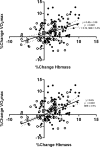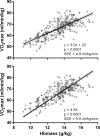Relationship between changes in haemoglobin mass and maximal oxygen uptake after hypoxic exposure
- PMID: 24282203
- PMCID: PMC3903146
- DOI: 10.1136/bjsports-2013-092841
Relationship between changes in haemoglobin mass and maximal oxygen uptake after hypoxic exposure
Abstract
Background: Endurance athletes have been using altitude training for decades to improve near sea-level performance. The predominant mechanism is thought to be accelerated erythropoiesis increasing haemoglobin mass (Hb(mass)) resulting in a greater maximal oxygen uptake (VO₂(max)). Not all studies have shown a proportionate increase in VO₂(max) as a result of increased Hb(mass). The aim of this study was to determine the relationship between the two parameters in a large group of endurance athletes after altitude training.
Methods: 145 elite endurance athletes (94 male and 51 female) who participated in various altitude studies as altitude or control participants were used for the analysis. Participants performed Hb(mass) and VO₂(max) testing before and after intervention.
Results: For the pooled data, the correlation between per cent change in Hb(mass) and per cent change in VO₂(max) was significant (p<0.0001, r(2)=0.15), with a slope (95% CI) of 0.48 (0.30 to 0.67) intercept free to vary and 0.62 (0.46 to 0.77) when constrained through the origin. When separated, the correlations were significant for the altitude and control groups, with the correlation being stronger for the altitude group (slope of 0.57 to 0.72).
Conclusions: With high statistical power, we conclude that altitude training of endurance athletes will result in an increase in VO₂(max) of more than half the magnitude of the increase in Hb(mass), which supports the use of altitude training by athletes. But race performance is not perfectly related to relative VO₂(max), and other non-haematological factors altered from altitude training, such as running economy and lactate threshold, may also be beneficial to performance.
Keywords: Aerobic fitness/Vo2 Max; Altitude; Elite performance; Endurance; Exercise.
Figures

 , n=145. Regression slope (solid line) and 95% CIs (dashed line) are shown. Top panel is for intercept free to vary, and bottom panel intercept constrained through the origin. Open circles are control participants and filled circles are altitude participants.
, n=145. Regression slope (solid line) and 95% CIs (dashed line) are shown. Top panel is for intercept free to vary, and bottom panel intercept constrained through the origin. Open circles are control participants and filled circles are altitude participants.
 , control (n=62), altitude (n=83). Regression slope (solid line) and 95% CIs (dashed line) are shown. Top panels are for intercept free to vary, and bottom panels for intercept constrained through the origin. Left-side graphs are control groups (including IHE and IHT alone) and right-side graphs are altitude groups.
, control (n=62), altitude (n=83). Regression slope (solid line) and 95% CIs (dashed line) are shown. Top panels are for intercept free to vary, and bottom panels for intercept constrained through the origin. Left-side graphs are control groups (including IHE and IHT alone) and right-side graphs are altitude groups.
 in raw units. Regression slope (solid line) and 95% CIs (dashed line) are shown. Data are cumulative for pre-exposure and postexposure to altitude, n = 290. Top panel is for intercept free to vary, and bottom panel intercept constrained through the origin.
in raw units. Regression slope (solid line) and 95% CIs (dashed line) are shown. Data are cumulative for pre-exposure and postexposure to altitude, n = 290. Top panel is for intercept free to vary, and bottom panel intercept constrained through the origin.Similar articles
-
The role of haemoglobin mass on VO(2)max following normobaric 'live high-train low' in endurance-trained athletes.Br J Sports Med. 2012 Sep;46(11):822-7. doi: 10.1136/bjsports-2012-091078. Epub 2012 Jul 12. Br J Sports Med. 2012. PMID: 22790809
-
Combining hypoxic methods for peak performance.Sports Med. 2010 Jan 1;40(1):1-25. doi: 10.2165/11317920-000000000-00000. Sports Med. 2010. PMID: 20020784 Review.
-
Complex networks analysis reinforces centrality hematological role on aerobic-anaerobic performances of the Brazilian Paralympic endurance team after altitude training.Sci Rep. 2022 Jan 21;12(1):1148. doi: 10.1038/s41598-022-04823-w. Sci Rep. 2022. PMID: 35064131 Free PMC article. Clinical Trial.
-
Combined intermittent hypoxic exposure at rest and continuous hypoxic training can maintain elevated hemoglobin mass after a hypoxic camp.J Appl Physiol (1985). 2024 Aug 1;137(2):409-420. doi: 10.1152/japplphysiol.00017.2024. Epub 2024 Jul 4. J Appl Physiol (1985). 2024. PMID: 38961820
-
Endurance training at altitude.High Alt Med Biol. 2009 Summer;10(2):135-48. doi: 10.1089/ham.2008.1092. High Alt Med Biol. 2009. PMID: 19519223 Review.
Cited by
-
Hemoglobin modulation affects physiology and patient reported outcomes in anemic and non-anemic subjects: An umbrella review.Front Physiol. 2023 Feb 15;14:1086839. doi: 10.3389/fphys.2023.1086839. eCollection 2023. Front Physiol. 2023. PMID: 36875043 Free PMC article. Review.
-
Metabolomic and Proteomic Profiling of Athletes Performing Physical Activity under Hypoxic Conditions.Sports (Basel). 2024 Mar 5;12(3):72. doi: 10.3390/sports12030072. Sports (Basel). 2024. PMID: 38535735 Free PMC article.
-
Evaluating the Impact of Urolithin A Supplementation on Running Performance, Recovery, and Mitochondrial Biomarkers in Highly Trained Male Distance Runners.Sports Med. 2025 Aug 21. doi: 10.1007/s40279-025-02292-5. Online ahead of print. Sports Med. 2025. PMID: 40839339
-
Effect of hypobaric hypoxia on hematological parameters related to oxygen transport, blood volume and oxygen consumption in adolescent endurance-training athletes.J Exerc Sci Fit. 2022 Oct;20(4):391-399. doi: 10.1016/j.jesf.2022.10.003. Epub 2022 Oct 18. J Exerc Sci Fit. 2022. PMID: 36348710 Free PMC article.
-
Autophagy Is a Promoter for Aerobic Exercise Performance during High Altitude Training.Oxid Med Cell Longev. 2018 Apr 5;2018:3617508. doi: 10.1155/2018/3617508. eCollection 2018. Oxid Med Cell Longev. 2018. PMID: 29849885 Free PMC article. Review.
References
-
- Levine BD, Stray-Gundersen J. ‘Living high-training low’: effect of moderate-altitude acclimatization with low-altitude training on performance. J Appl Physiol 1997;83:102–12 - PubMed
-
- Levine BD, Stray-Gundersen J, Gore CJ, et al. Point: counterpoint: positive effects of intermittent hypoxia (live high:train low) on exercise are/are not mediated primarily by augmented red cell volume. J Appl Physiol 2005;99:2053–5; discussion 2055–2058 - PubMed
-
- Stray-Gundersen J, Chapman RF, Levine BD. ‘Living high-training low’ altitude training improves sea level performance in male and female elite runners. J Appl Physiol 2001;91:1113–20 - PubMed
-
- Wagner PD. New ideas on limitations to VO2max. Exerc Sport Sci Rev 2000;28:10–14 - PubMed
-
- Schmidt W, Heinicke K, Rojas J, et al. Blood volume and hemoglobin mass in endurance athletes from moderate altitude. Med Sci Sports Exerc 2002;34:1934–40 - PubMed
Publication types
MeSH terms
Substances
LinkOut - more resources
Full Text Sources
Other Literature Sources
